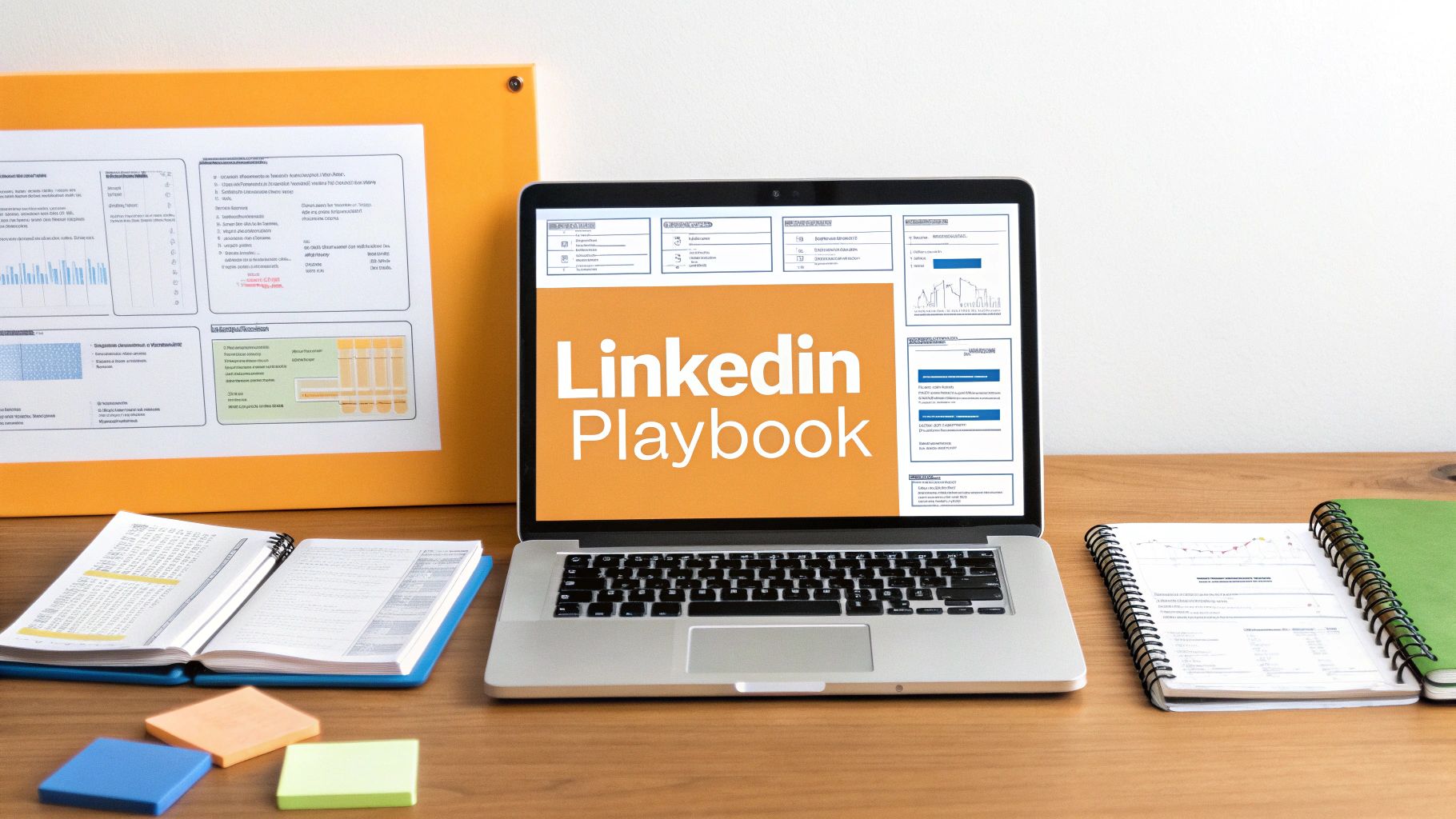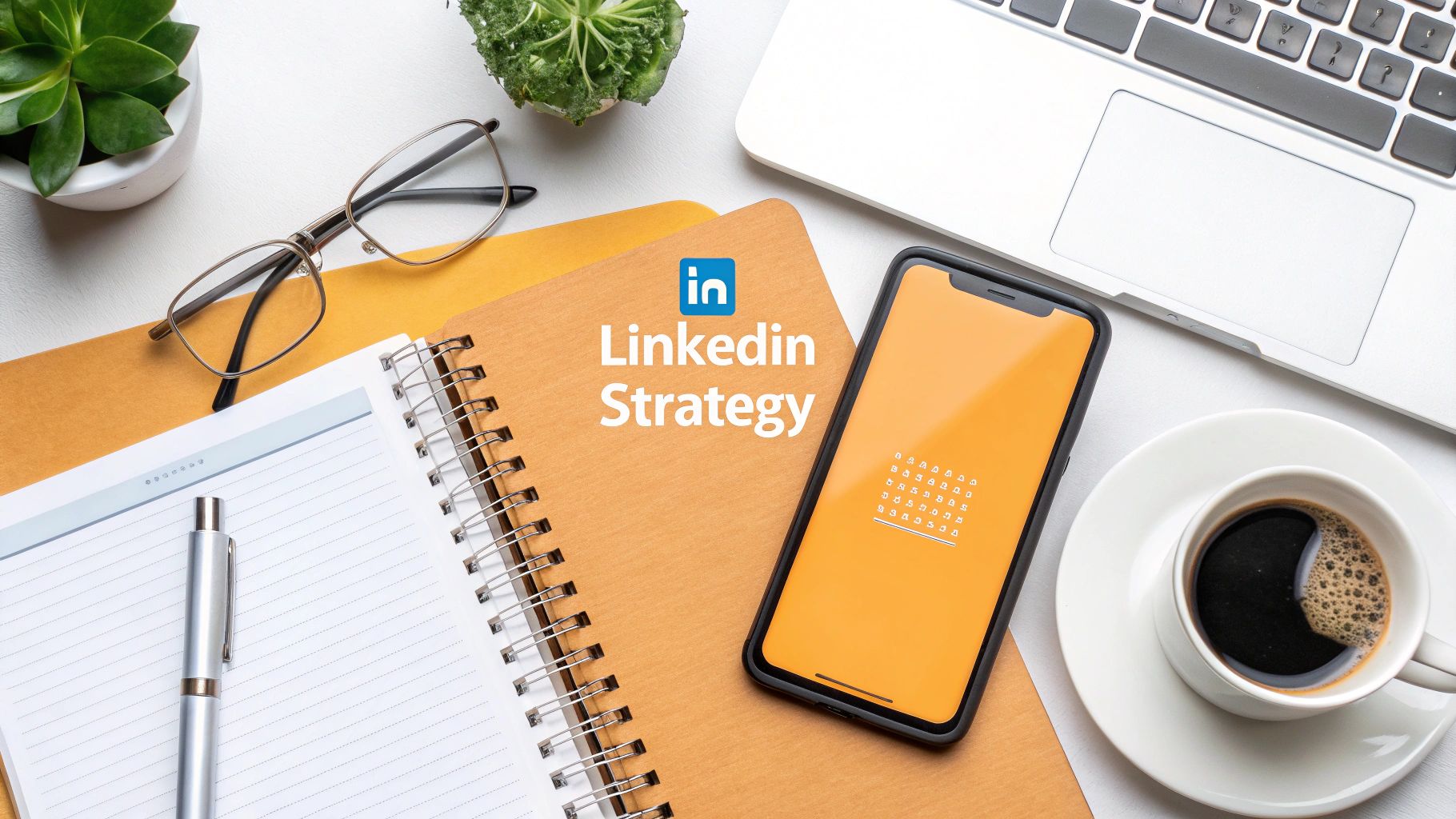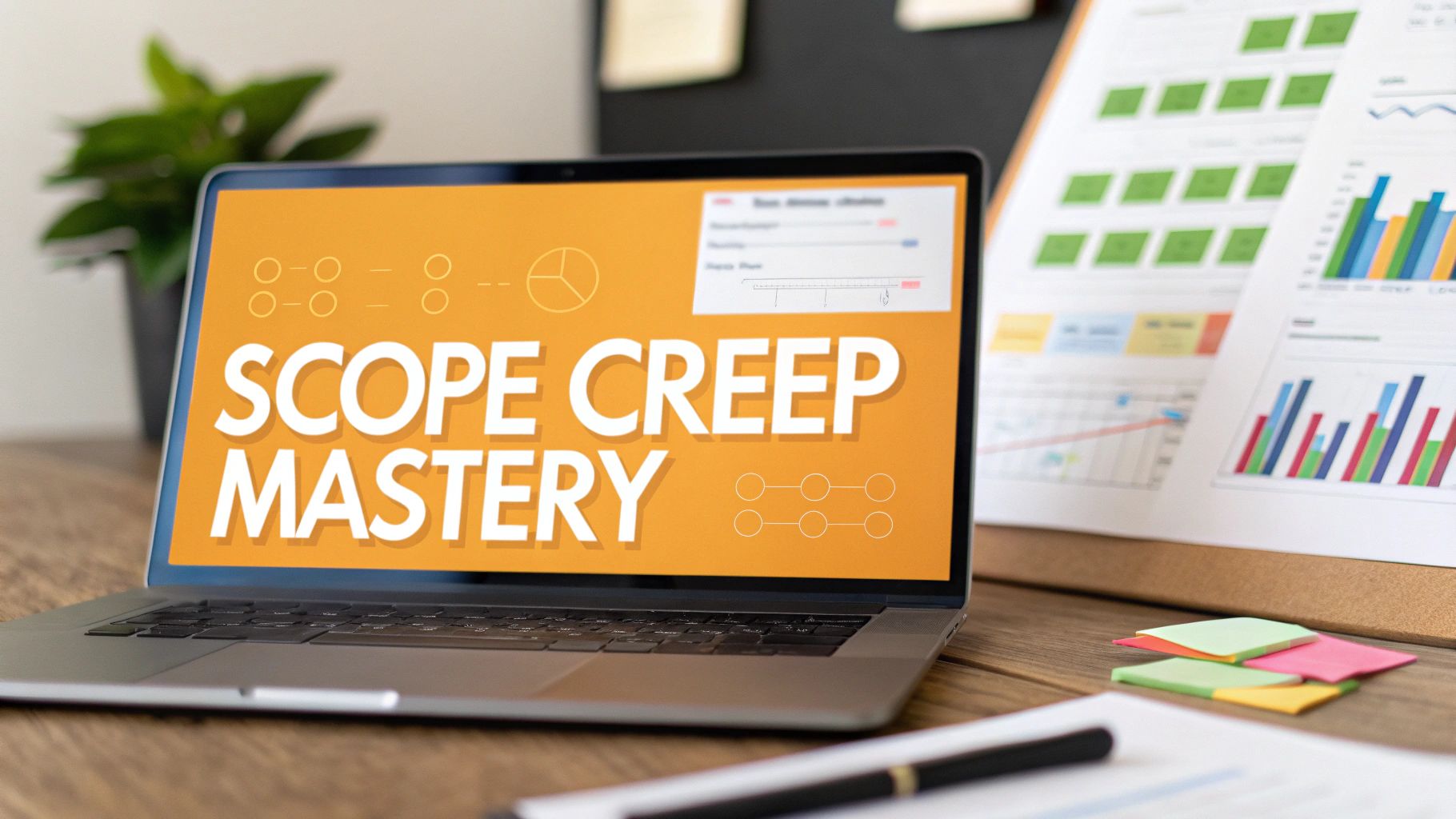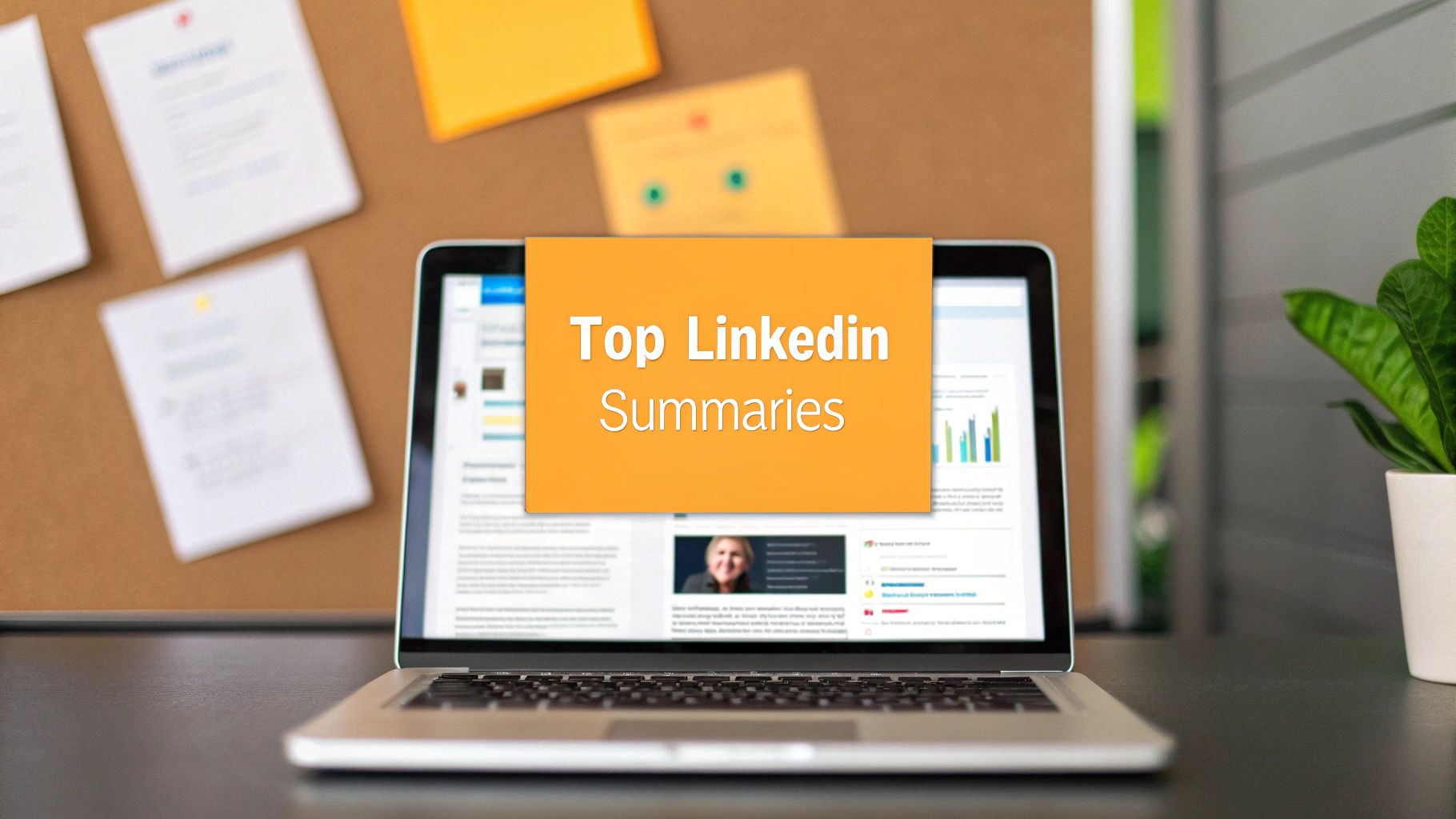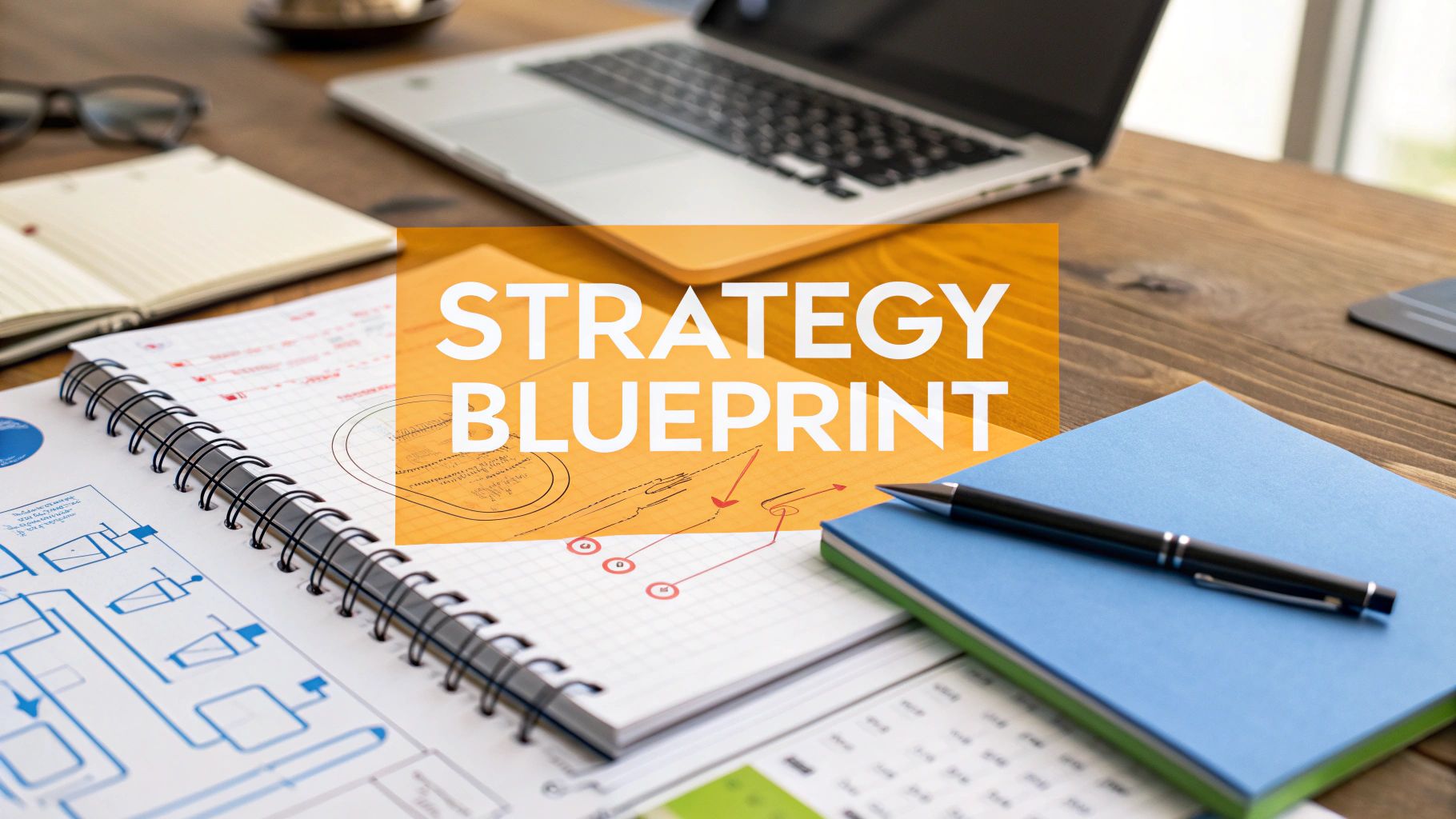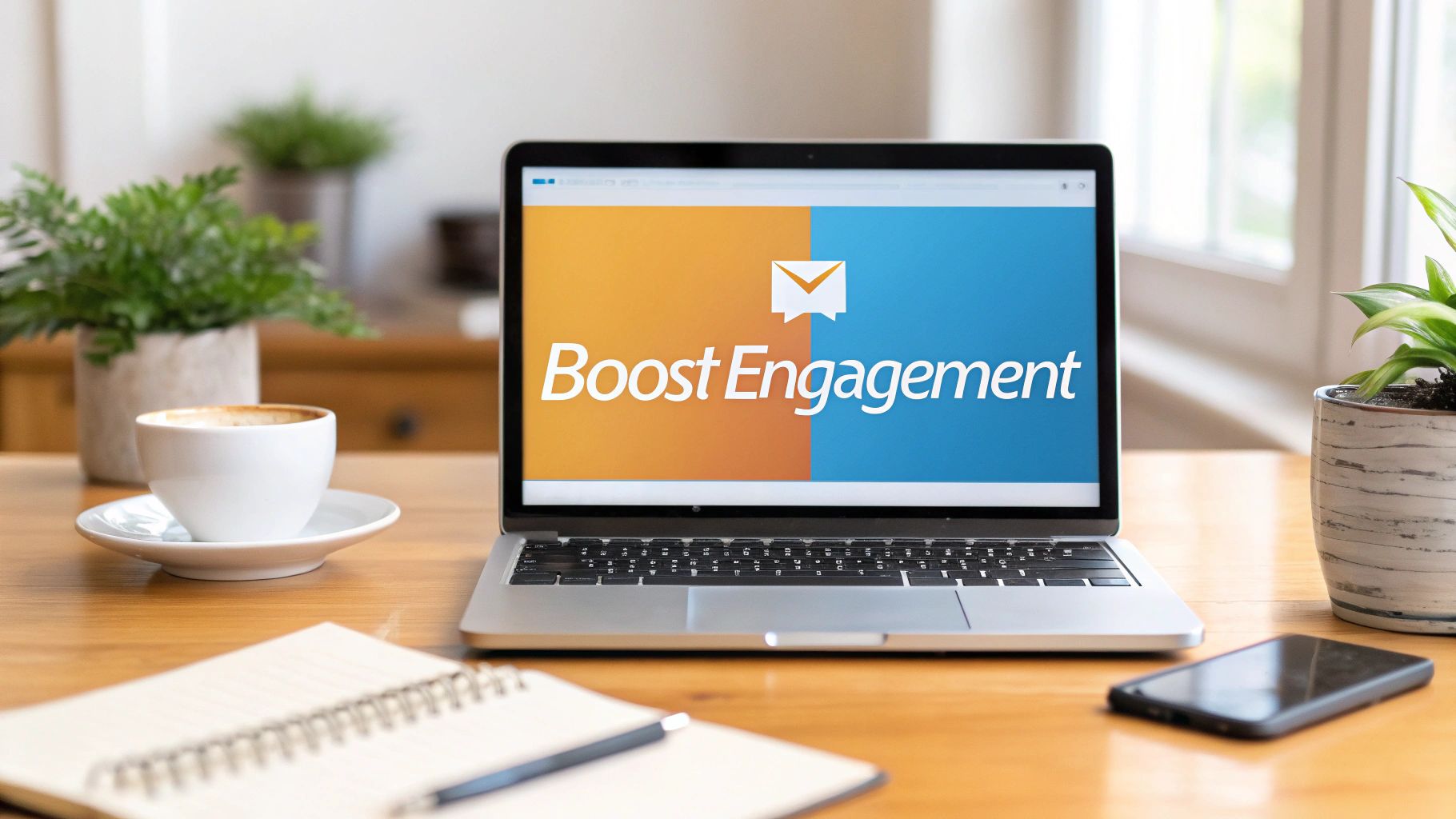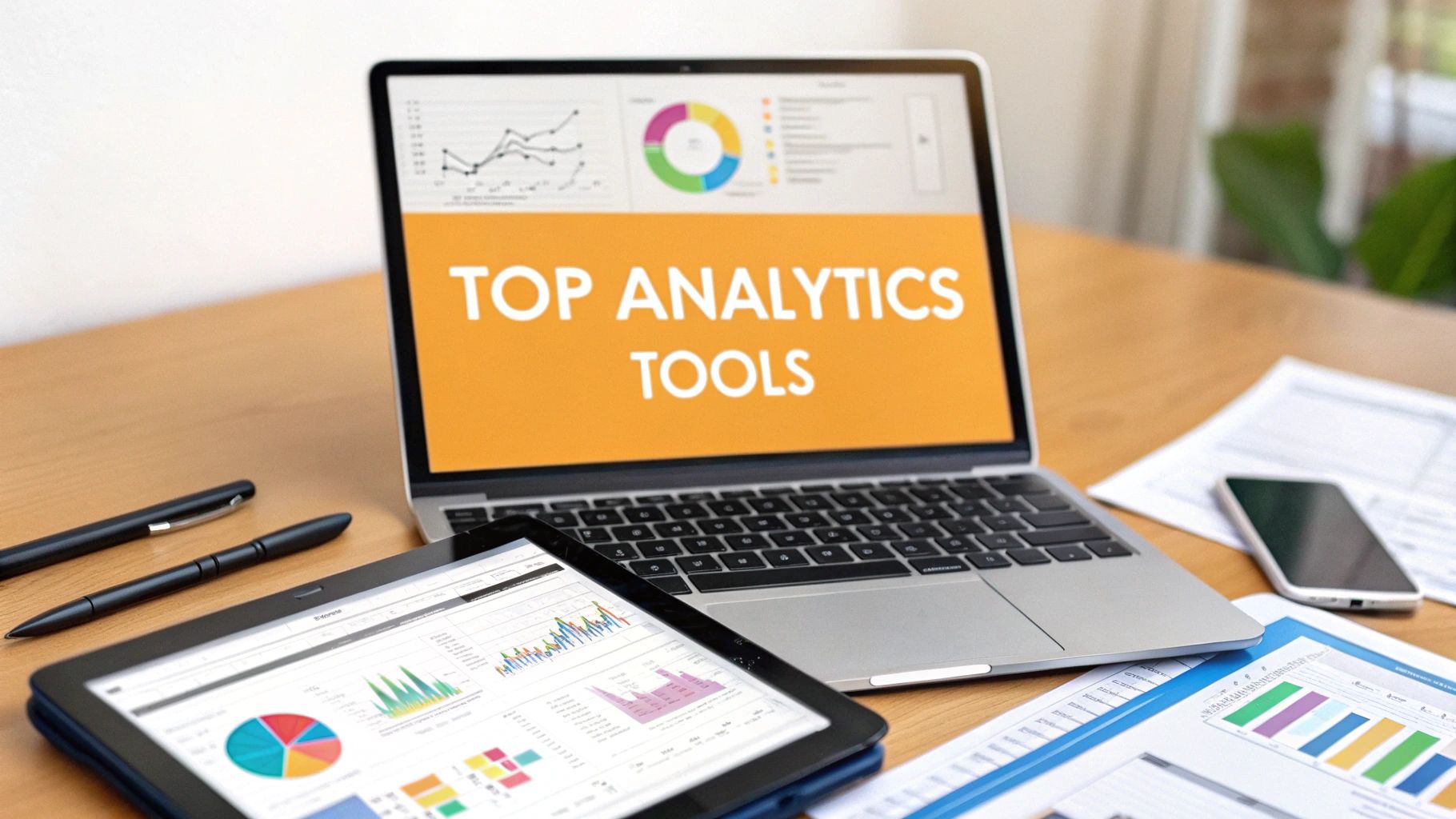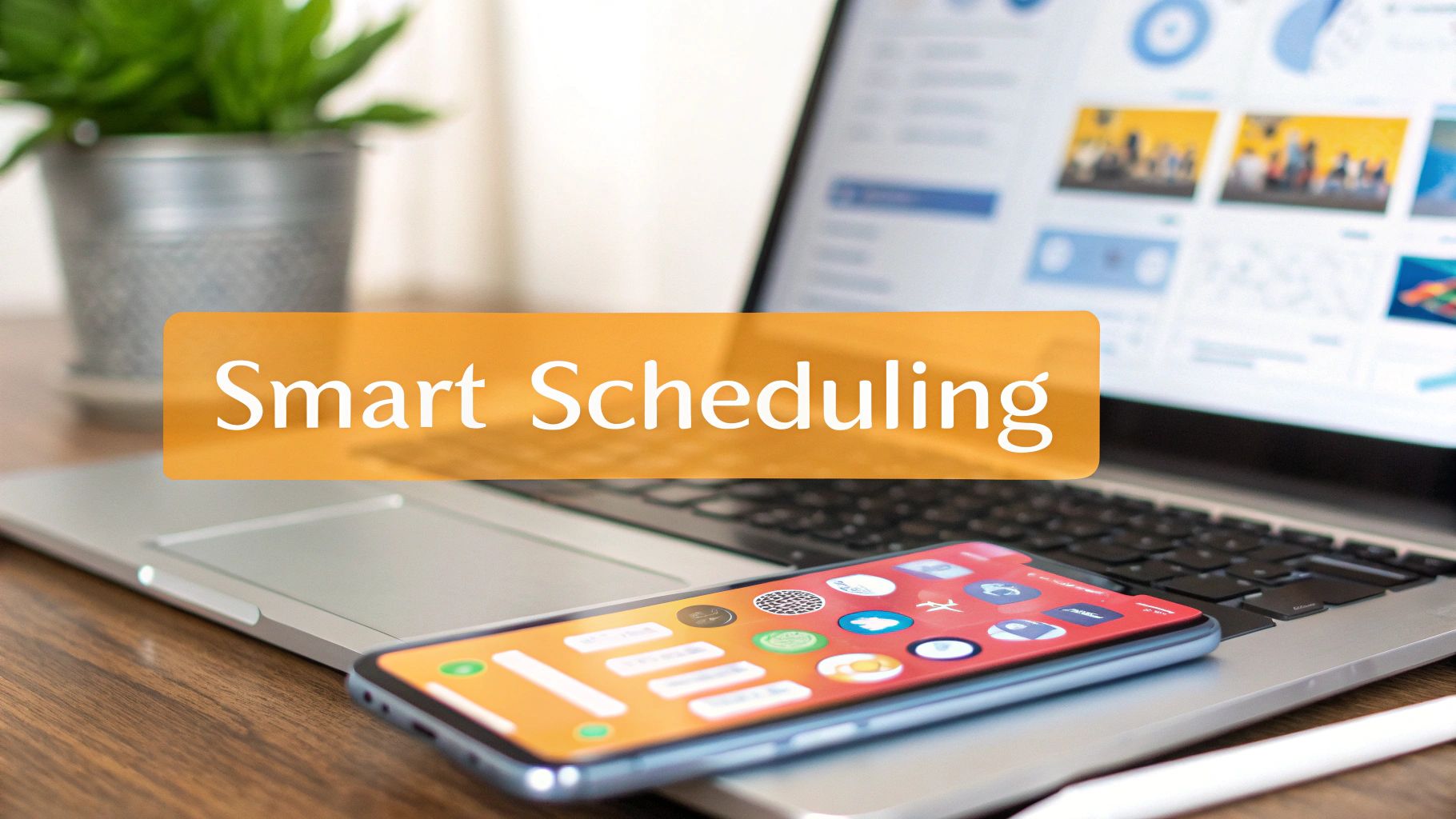If your pipeline feels inconsistent and your reps are struggling to book meetings, you're not alone. The world of sales is noisy, and generic outreach just doesn't cut it anymore. Effective prospecting isn't about blasting more emails or making more calls; it's about precision, personalization, and process. It’s the difference between chasing dead-end leads and consistently engaging high-value buyers who actually want to talk to you.
This guide is designed to cut through the fluff. We’re not here to give you vague theories. Instead, we’re breaking down the 10 essential sales prospecting best practices that top-performing teams are using right now to build predictable pipeline and crush their quotas. Each point is a practical, actionable step you can implement immediately to refine your strategy.
You'll learn how to define your ideal customer with surgical precision, leverage intent data to find buyers who are ready to act, and craft outreach that feels personal, not automated. We’ll cover everything from structuring your sales development team to optimizing your CRM for maximum efficiency. It's time to transform your outreach from a guessing game into a revenue-generating machine. Let’s dive in.
1. Define Your Ideal Customer Profile (ICP)
Stop wasting time chasing leads that will never close. One of the most fundamental sales prospecting best practices is defining your Ideal Customer Profile (ICP). An ICP isn't just a vague idea of who you sell to; it's a hyper-specific description of the company that gets the most value from your product and, in turn, provides the most value back to you.
Think of it as your prospecting North Star. By creating a detailed ICP, you focus your energy exclusively on high-fit accounts that are most likely to convert, stick around, and become your biggest advocates. This prevents your team from spinning their wheels on dead-end conversations and dramatically improves sales efficiency. For example, HubSpot specifically targets mid-market companies in high-growth industries, while Salesforce hones in on enterprises in verticals like financial services.
How to Implement Your ICP
- Analyze Your Best Customers: Survey your top 10-20% of customers. Look for common threads in their industry, company size, revenue, technology stack, and even the challenges they faced before buying from you.
- Validate with Data: Use intent data and predictive analytics tools to confirm that your hypothesized ICP is actively searching for solutions like yours.
- Collaborate and Share: Your ICP shouldn't live in a silo. Share it across your entire go-to-market team (sales, marketing, customer success) to ensure everyone is aligned.
Pro Tip: Your ICP isn't set in stone. Regularly review and update it based on win/loss analysis and market shifts. As your product evolves, your ideal customer might too. An effective ICP is the foundation for creating detailed buyer personas. To dive deeper, you can learn more about creating buyer personas here.
2. Implement Account-Based Prospecting (ABP) and Leverage Intent Data
Instead of casting a wide net, Account-Based Prospecting (ABP) flips the funnel. This highly strategic approach focuses your sales and marketing resources on a curated list of high-value target accounts that perfectly match your ICP. The goal is to treat each account as its own market, engaging key decision-makers with hyper-personalized outreach.
This is where intent data becomes a game-changer. By tracking online signals, you can identify which of your target accounts are actively researching solutions like yours right now. This allows your team to time their outreach perfectly, engaging prospects when buying intent is at its peak. For instance, platforms like 6sense and Demandbase use predictive analytics to surface these "in-market" accounts, turning cold outreach into warm, relevant conversations.

How to Implement ABP and Intent Data
- Start Small with a Pilot: Select a focused list of 20-50 high-fit target accounts. This allows you to test and refine your messaging, plays, and measurement before scaling.
- Combine Data Sources: Use a mix of first-party data (your website visitors, CRM activity) and third-party intent data from providers like Bombora to get a complete picture of an account's buying journey.
- Create Account Playbooks: Develop specific outreach sequences and messaging tailored to each target account’s pain points and industry. Ensure sales and marketing are aligned on these plays.
Pro Tip: Set up real-time alerts for high-intent signals, such as a target account visiting your pricing page or competitor's site. This enables immediate, context-aware follow-up when the lead is hottest. The key to successful ABP is measuring account engagement and pipeline progression, not just lead volume. To see how a leader in this space operates, you can learn more about Demandbase's approach here.
3. Develop Personalized Outreach Sequences
Generic, one-size-fits-all outreach is dead. A crucial sales prospecting best practice is to develop personalized, multi-step outreach sequences that build relationships instead of just asking for a meeting. A sequence is a series of strategic touchpoints across different channels like email, phone, and social media, designed to engage a prospect over time. This approach ensures you stay top-of-mind without being annoying.
Instead of a single "just checking in" email, you're delivering value at each step. For example, a sequence might start with a personalized email referencing a prospect's recent LinkedIn post, followed by a connection request, then a call, and later an email sharing a relevant case study. Platforms like Outreach.io and Salesloft specialize in helping teams build, automate, and track these multi-channel playbooks.

How to Implement Personalized Sequences
- Map Your Touchpoints: Plan a sequence of 5-7 touches over 2-3 weeks. Mix your channels: combine two or three emails with a phone call, a LinkedIn message, and a profile view to maximize visibility.
- Personalize the Hook: The first sentence of any email or message is critical. Reference a specific company trigger event, a recent article they wrote, or a mutual connection to show you've done your homework.
- Add Value, Don't Just Ask: In your follow-ups, share a relevant blog post, an insightful industry statistic, or a short video explaining a concept. Make every interaction useful to the prospect, not just to you.
Pro Tip: Don't be afraid to use creative touchpoints. A short, personalized video message recorded with a tool like Loom or Vidyard can cut through the noise and make a memorable impression. Always A/B test your sequences to see which channels, messaging, and timing generate the best response rates.
4. Use Social Selling and LinkedIn Prospecting
Cold calls and emails aren't the only way to reach prospects. A core component of modern sales prospecting best practices involves leveraging social platforms like LinkedIn to build relationships before you ever ask for a meeting. Social selling is the art of using your professional network to find the right prospects, build trusted relationships, and ultimately, achieve your sales goals.
It's about warming up your audience by providing value upfront. Instead of a hard pitch, you're sharing insightful content, engaging with their posts, and establishing yourself as a credible authority in your space. For instance, sales leaders like Jeb Blount and Kyle Porter use consistent, high-value LinkedIn engagement not just for branding, but as a powerful engine for generating highly qualified inbound leads.

How to Implement Social Selling
- Optimize Your Profile: Your LinkedIn profile should be a resource for your target audience, not just a resume. Use your headline and summary to speak directly to their pain points and how you help solve them.
- Engage Before Connecting: Don't just send a blind connection request. Like and comment thoughtfully on a prospect's recent posts or articles for a few days before reaching out. This makes your name familiar.
- Provide Value Consistently: Share relevant third-party articles, create your own content, and offer insights 3-5 times per week. This builds your authority and keeps you top-of-mind without being salesy.
Pro Tip: Use LinkedIn Sales Navigator to build hyper-targeted prospect lists and set up alerts for their activity. When you see a prospect has changed jobs or their company is mentioned in the news, you have a perfect, timely reason to reach out. To master this platform, you can explore more LinkedIn lead generation strategies here.
5. Conduct Thorough Prospect Research and Discovery
Stop sending generic, templated messages that get ignored. A cornerstone of modern sales prospecting best practices is conducting deep research before you ever reach out. This isn't just about finding a name and email; it's about understanding the prospect’s company, their role, their challenges, and recent trigger events that make your solution relevant right now.
Think of research as your secret weapon for personalization. By uncovering specific details, you can craft a message that resonates, demonstrates credibility, and proves you’ve done your homework. For instance, referencing a company’s recent funding round, a new executive hire, or a direct quote from their earnings call shows you’re a serious partner, not just another spammer. This approach immediately sets you apart and dramatically increases your reply rates.
How to Implement Prospect Research
- Create a Research Checklist: Standardize your process. Your checklist could include verifying company size, recent news or press releases, key initiatives mentioned in their annual report, and identifying the prospect’s recent activity on LinkedIn.
- Leverage Sales Intelligence Tools: Don’t do it all manually. Use platforms like ZoomInfo, Apollo, or Crunchbase to quickly gather firmographic data, tech stack information, and news alerts, freeing up your time for deeper, more strategic insights.
- Look for Trigger Events: Focus on "why now?" Triggers can be anything from a new product launch, a hiring surge in a specific department, a bad quarter, or a change in leadership. These are powerful hooks for your outreach.
Pro Tip: Time-box your research to stay efficient. Spend no more than 10-15 minutes per high-value prospect. Set up Google Alerts for your top target accounts and follow their key executives on social media to have insights delivered directly to you. This keeps you informed without derailing your day.
6. Implement a Structured Sales Development Organization
Don't expect your closers to be expert prospectors. A critical best practice for scaling your pipeline is to implement a structured Sales Development Organization. This means creating dedicated roles, typically Sales Development Reps (SDRs) or Business Development Reps (BDRs), whose sole focus is on top-of-funnel activities: researching, prospecting, and qualifying leads before handing them off to Account Executives (AEs).
This specialization model allows AEs to focus on what they do best: conducting demos and closing deals. It creates a predictable and scalable pipeline machine. Tech giants like Salesforce and HubSpot built their empires on this model, employing dedicated SDR teams to generate a consistent flow of high-quality opportunities. This division of labor boosts efficiency and ensures a higher quality of meetings for your closing team.
How to Implement a Sales Development Organization
- Define Clear Roles and Handoffs: Create a specific Service Level Agreement (SLA) that outlines exactly what constitutes a "sales-qualified lead" and the process for handing it off from an SDR to an AE.
- Establish Activity and Outcome Metrics: Set clear, achievable targets for your SDRs. Common benchmarks include 50-100 calls and 200-300 emails per week, with the goal of setting 3-5 qualified meetings.
- Create a Career Path: Motivate your SDRs by showing them a clear advancement path. A typical progression moves from SDR to a closing role like an AE, which helps with retention and long-term team building.
Pro Tip: When hiring SDRs, prioritize coachability, resilience, and drive over direct experience. A great SDR can be trained on your product and process, but intrinsic motivation is harder to teach. To learn more about structuring these teams, look into frameworks popularized by firms like SiriusDecisions (now part of Forrester).
7. Optimize Email Subject Lines and Opening Hooks
Your perfectly crafted email is useless if it never gets opened. Optimizing your subject line and opening hook is one of the highest-impact sales prospecting best practices because it’s the first hurdle you must clear to get a prospect’s attention in a crowded inbox. A compelling subject line sparks curiosity, while the first sentence confirms the email is relevant and worth reading.
Think of the subject line as the movie trailer and the opening hook as the first scene. For example, a generic subject like "Introductory Call" gets deleted instantly. In contrast, a specific and personalized one like "Quick idea for [Company]'s new product line" compels the prospect to click. A strong opener immediately validates their decision, such as, "Saw you just launched your X series; thought this might be relevant..."
How to Implement Optimized Hooks
- A/B Test Aggressively: Don't guess what works. Continuously test 2-3 subject line variations on a small segment of your list to identify what resonates most with your audience. Even small improvements in open rates compound significantly over time.
- Keep it Mobile-First: Most emails are opened on mobile devices, which truncate long subject lines. Aim for 30-50 characters to ensure your full message is visible.
- Personalize with Purpose: Go beyond just using
[First Name]. Reference a recent company event, a LinkedIn post, or a new hire to show you've done your homework.
Pro Tip: The preview text that appears next to the subject line in most email clients is prime real estate. Use it to extend your hook, ask a compelling question, or provide a snippet of value. For crafting concise and impactful messages that capture attention instantly, it's worth exploring tools for optimizing your email subject lines.
8. Build a Robust CRM and Pipeline Management System
Your prospecting efforts are only as good as the system you use to track them. A Customer Relationship Management (CRM) system is the central nervous system for your sales operation, providing a single source of truth for all prospect interactions, pipeline stages, and sales activities. Without it, valuable context gets lost in spreadsheets, inboxes, and notepads, leading to dropped leads and inconsistent follow-up.
A well-maintained CRM transforms chaotic prospecting into a predictable, measurable process. It ensures every lead is tracked, every interaction is logged, and every salesperson knows their next step. For example, Salesforce, the market leader, helps enterprise teams manage complex sales cycles, while platforms like HubSpot and Pipedrive offer more intuitive, visual pipeline management ideal for small to mid-sized businesses.
How to Implement Your CRM System
- Establish Clear Governance: Define exactly what information gets tracked, when it needs to be updated, and who is responsible. Create a simple “CRM playbook” for your team.
- Automate to Reduce Friction: Use workflows to automate manual tasks like logging emails, scheduling follow-ups, and updating deal stages. This improves data accuracy and saves reps time.
- Integrate Your Sales Stack: Connect your CRM with your email, calendar, and communication tools (like Slack or Teams) to create a seamless workflow and capture all interactions automatically.
Pro Tip: The best CRM is the one your team actually uses. Focus on user adoption through initial training, ongoing support, and by demonstrating its value in making their jobs easier. Regularly review CRM reports during team meetings to identify pipeline gaps, coach reps, and maintain data hygiene.
9. Execute Phone Prospecting and Cold Calling Strategy
In an age of endless emails and social media DMs, the phone remains a uniquely powerful tool. Executing a smart phone prospecting and cold calling strategy allows you to cut through the digital noise, have real conversations, and build human connections that are difficult to forge through text alone. It’s a direct, immediate channel for qualifying prospects and moving deals forward.
This isn’t about mindlessly dialing for dollars; it’s a surgical approach to engaging high-value targets. As Jeb Blount emphasizes in 'Fanatical Prospecting', consistent, skilled phone outreach is a non-negotiable part of a comprehensive sales prospecting best practices plan. It works because it forces a real-time response and allows for dynamic conversation, making it one of the most effective ways to book meetings when combined with other touchpoints like email and social selling.
How to Implement Your Calling Strategy
- Time Your Dials: Schedule dedicated calling blocks during high-connect windows. Data often points to the hour before lunch, the hour after lunch, and late afternoon as prime times to reach decision-makers.
- Prepare for Gatekeepers: Don't view receptionists or executive assistants as obstacles. Treat them as allies. Have a clear, respectful script ready to explain your purpose and ask for their help in reaching the right person.
- Use a Multi-Touch Cadence: Combine your calls with emails and social media interactions. A popular and effective sequence is to email, call, leave a voicemail, and then follow up with another email or a LinkedIn connection request.
Pro Tip: Expect to reach voicemail around 80% of the time. Don’t get discouraged; instead, master the art of the compelling voicemail. Keep it under 30 seconds, state a clear reason for your call, and provide a specific call-to-action. For those looking to refine their approach to direct phone outreach, exploring powerful cold calling scripts can significantly enhance your effectiveness.
10. Measure, Test, and Continuously Optimize Prospecting Efforts
You can't improve what you don't measure. One of the most critical sales prospecting best practices is to treat your outreach like a science experiment: form a hypothesis, test it, analyze the data, and iterate. What worked last quarter might be ineffective today, so a disciplined approach to tracking and optimization is non-negotiable for sustained success.
Adopting this mindset means moving beyond simply tracking activities and focusing on outcomes. For example, instead of just counting calls made, a data-driven team analyzes call-to-connect rates and connect-to-meeting conversion rates, then tests different call times to improve those metrics. This continuous feedback loop transforms prospecting from a guessing game into a predictable, scalable engine for generating pipeline.
How to Implement Continuous Optimization
- Establish Core Metrics: Track 5-7 key performance indicators (KPIs) like email open/reply rates, call connect rates, meetings booked per prospect, and opportunity conversion rates.
- Run Controlled Tests: Dedicate each month to testing one specific variable. This could be a new subject line format, a different call-to-action in your emails, or calling prospects in the late afternoon instead of the morning.
- Hold Weekly Pipeline Reviews: Use these meetings to analyze performance data, not just review deals. Discuss what's working, identify trends, and share successful tactics across the team to lift everyone's performance.
Pro Tip: Your prospecting metrics tell a story about what your ideal customers care about. If a particular email template is getting high engagement, the messaging likely resonates. This insight is gold for your marketing team. To go deeper, you can learn more about measuring performance here.
Sales Prospecting: 10 Best Practices Comparison
| Approach | 🔄 Implementation complexity | 💡 Resource requirements | 📊 Expected outcomes | ⚡ Speed / efficiency | ⭐ Key advantages |
|---|---|---|---|---|---|
| Define Your Ideal Customer Profile (ICP) | 🔄 Moderate — research & data modeling, needs updates | 💡 Customer data, analytics tools, time for research | 📊 Better targeting: higher conversion, larger deal sizes (30–50%) | ⚡ Medium — upfront work; benefits compound over time | ⭐ Aligns sales/marketing; enables predictive prospecting |
| Implement Account-Based Prospecting (ABP) & Intent Data | 🔄 High — cross-functional processes and tech integration | 💡 High-cost stack (intent providers, CRM, automation), dedicated team | 📊 Significant lift in deal size and win rates; higher ROI | ⚡ Medium–Slow — pilot then scale; real-time alerts speed action | ⭐ Highly targeted outreach at peak buying intent |
| Develop Personalized Outreach Sequences | 🔄 Medium — content creation + conditional logic | 💡 Sequence tools, content creation, testing time | 📊 Increased response and meeting rates (50–300% uplift) | ⚡ Medium — can launch quickly, optimizes with testing | ⭐ Scalable multi-channel personalization |
| Use Social Selling & LinkedIn Prospecting | 🔄 Low–Medium — consistent activity and profile work | 💡 LinkedIn Sales Navigator, content time; low cash cost | 📊 Improved credibility and open/response rates; relationship building | ⚡ Slow — relationship-driven, builds over weeks | ⭐ Builds trust and low-cost long-term engagement |
| Conduct Thorough Prospect Research & Discovery | 🔄 Medium–High — deep, prospect-level work | 💡 Research tools (ZoomInfo, Crunchbase), time per prospect | 📊 Higher relevancy and reply rates; better-qualified meetings | ⚡ Slow — time-intensive but improves downstream speed | ⭐ Enables highly relevant, credible outreach |
| Implement a Structured Sales Development Org | 🔄 High — org design, hiring, SLAs, training | 💡 Headcount, training programs, management and coaching | 📊 More AE productivity; predictable pipeline and activity metrics | ⚡ Medium — ramp time (3–6 months) | ⭐ Scales prospecting with specialization and accountability |
| Optimize Email Subject Lines & Opening Hooks | 🔄 Low — A/B testing and copy refinement | 💡 Minimal tools (email platform), copywriting and testing time | 📊 Boosts open rates (30–100%) and downstream replies | ⚡ Fast — quick wins from iterative tests | ⭐ High-impact, low-cost improvement area |
| Build a Robust CRM & Pipeline Management System | 🔄 High — implementation, governance, integrations | 💡 CRM licenses, integration work, admin and training | 📊 Clear pipeline visibility, better forecasting, consistent follow-up | ⚡ Medium — setup fast; benefits grow with adoption | ⭐ Centralizes data and improves revenue predictability |
| Execute Phone Prospecting & Cold Calling | 🔄 Medium — scripting, coaching, compliance considerations | 💡 Skilled reps, dialers, call recording, quality coaching | 📊 High channel conversion on connects (notable meeting rates) | ⚡ Fast — immediate feedback and quick iteration | ⭐ Direct conversations enable fast qualification & objection handling |
| Measure, Test & Continuously Optimize Prospecting | 🔄 Medium — disciplined processes and experimentation | 💡 Analytics, dashboards, testing framework, coaching time | 📊 Continuous performance gains; data-driven improvements | ⚡ Medium — tests take weeks; gains compound over time | ⭐ Drives sustained improvement and scalable best practices |
From Prospecting to Pipeline Powerhouse
So, there you have it. We've journeyed through the entire sales prospecting landscape, from laying the foundational groundwork of your Ideal Customer Profile (ICP) to the nitty-gritty of optimizing your email subject lines and executing a killer cold call. It’s a lot to take in, but the path to becoming a pipeline powerhouse isn't about finding one secret hack. It’s about building a disciplined, repeatable system that consistently delivers results.
Think of these sales prospecting best practices as interconnected gears in a machine. Your hyper-specific ICP (Item #1) fuels your Account-Based Prospecting strategy (Item #2). Thorough research (Item #5) gives you the ammunition to create deeply personalized outreach sequences (Item #3) that actually get a response. Meanwhile, your consistent efforts on social channels (Item #4) warm up the ground for your phone calls (Item #9) and emails (Item #7), making every touchpoint more effective.
Weaving It All Together
The real magic happens when you stop viewing these practices in isolation. Instead, see them as a cohesive strategy that transforms your sales efforts from random acts of outreach into a predictable engine for growth.
- Foundation First: Everything starts with knowing exactly who you're targeting. A vague ICP leads to wasted effort.
- Personalization is Paramount: Generic outreach is dead. Your prospects expect you to have done your homework and to understand their specific challenges.
- Technology as an Enabler: A robust CRM (Item #8) isn't just a database; it’s your command center. It empowers you to track, manage, and scale your efforts effectively.
- Never Stop Optimizing: What works today might not work tomorrow. Continuously measuring and testing your approach (Item #10) is the only way to stay ahead and ensure your pipeline remains full.
Mastering these concepts isn't just about hitting quota; it's about building a sustainable career and a thriving business. By implementing these sales prospecting best practices one by one, measuring your results, and refining your process, you turn what many see as a grueling chore into your single greatest competitive advantage. The goal is to evolve from just doing prospecting to truly owning your pipeline. Now, go make it happen.
Ready to supercharge your social selling and build a powerful personal brand that attracts high-quality leads? Let RedactAI handle your LinkedIn content creation, so you can focus on closing deals. Check out how RedactAI can help you consistently publish high-impact posts that warm up your outbound efforts and bring prospects to you.





